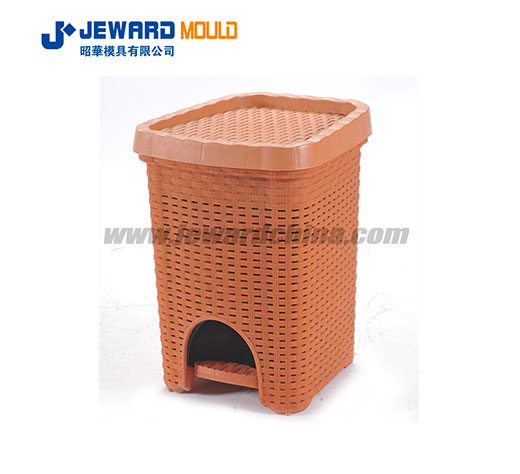A gate is installed in the upper clad plate of the existing large-scale dust bin mould, and a flow channel is formed in the fixed template, which is opposite to the flow channel, communicates with the dust bin mould cavity, and is located at the bottom of the trash can formed by the dust bin mould cavity. Generally, a 2,800-ton injection molding machine is required, and the temperature of the plastic melted by the injection molding machine needs to reach 280~320 °C. The plastic has good fluidity after being heated, and the pressure required to inject high pressure into the cavity of the injection mold is generally above 220mpa, which is inconvenient to use.
Technicians provide a dust bin mould with simple structure, shortened process, reduced wall thickness, low production cost and convenient use. The dustbin mould is realized by the following technical solutions: manufacturing dust bin mould, including fixed mold assembly and movable mold assembly matched with fixed mold assembly, fixed mold assembly including lower composite plate and core blocks fixed on the lower composite plate, movable mold The component includes an upper composite plate and a cavity block fixed on the upper composite plate. The mold of the dust bin mould is mainly provided with a discharge structure in the middle of the core block, and the hot runner communicates with the trash can cavity through the discharge structure. The purpose is to reduce the flow of the hot runner, reduce the barrel wall of the molding trash can, and reduce the production cost. The requirements for the injection molding machine are lower, and the use is convenient.
There are four casting installation positions distributed circumferentially in the middle of the pellet. The size and shape of the casting parts match the casting installation positions. It is connected with the hot runner, and the gate outlet end of the pouring part is connected with the trash can cavity; the four pouring installation positions are evenly distributed in the middle of the pellets at circumferential intervals. The end is located in the middle of the corner of the trash can cavity forming the trash can.

The lower end of the upper core block is circumferentially spaced with four lower clamping grooves, the upper end of the lower core block is circumferentially spaced with four upper clamping grooves, and the lower clamping grooves and the upper clamping grooves are correspondingly distributed up and down. The purpose of this arrangement is to manufacture the pellets separately, which facilitates production and processing of the pellets, and facilitates assembly, maintenance and use.
Compared with the prior art, the above-mentioned trash can mould is simple in structure and reasonable in structure design; when the trash can is formed, the flow rate of the hot runner can be shortened by half; the wall of the trash can after molding becomes thinner, and the weight is generally less than 7 kilograms; the production cost is low; The requirements of the injection molding machine are relatively low, and the injection molding machine can produce it. The temperature of the plastic melted by the injection molding machine only needs to reach 220~250 °C, and high pressure can be injected into the injection mold.
Jeward Mould excels as a company dedicated to plastic mold manufacturing, possessing the expertise to utilize various mold technologies. Our specialization lies in Thin wall mould, Multi-shot molding, Large-part injection molding, and Gas assist molding. This proficiency empowers us to craft tailor-made plastic injection molds for sale, perfectly suited to cater to a diverse array of industries and manufacturing needs.
